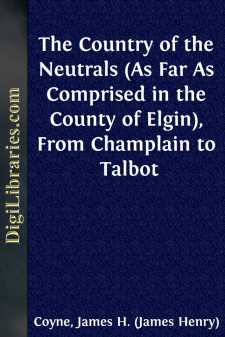Categories
- Antiques & Collectibles 13
- Architecture 36
- Art 48
- Bibles 22
- Biography & Autobiography 813
- Body, Mind & Spirit 142
- Business & Economics 28
- Children's Books 16
- Children's Fiction 13
- Computers 4
- Cooking 94
- Crafts & Hobbies 4
- Drama 346
- Education 46
- Family & Relationships 57
- Fiction 11829
- Games 19
- Gardening 17
- Health & Fitness 34
- History 1377
- House & Home 1
- Humor 147
- Juvenile Fiction 1873
- Juvenile Nonfiction 202
- Language Arts & Disciplines 88
- Law 16
- Literary Collections 686
- Literary Criticism 179
- Mathematics 13
- Medical 41
- Music 40
- Nature 179
- Non-Classifiable 1768
- Performing Arts 7
- Periodicals 1453
- Philosophy 64
- Photography 2
- Poetry 896
- Political Science 203
- Psychology 42
- Reference 154
- Religion 513
- Science 126
- Self-Help 84
- Social Science 81
- Sports & Recreation 34
- Study Aids 3
- Technology & Engineering 59
- Transportation 23
- Travel 463
- True Crime 29
The Country of the Neutrals (As Far As Comprised in the County of Elgin), From Champlain to Talbot
Description:
Excerpt
In that part of the township of Southwold included in the peninsula between Talbot Creek and the most westerly bend of Kettle Creek there were until a relatively recent date several Indian earthworks, which were well-known to the pioneers of the Talbot Settlement. What the tooth of time had spared for more than two centuries yielded however to the settler's plough and harrow, and but one or two of these interesting reminders of an almost forgotten race remain to gratify the curiosity of the archæologist or of the historian. Fortunately, the most important of all is still almost in its original condition. It is that, which has become known to readers of the Transactions of the Canadian Institute as the Southwold Earthwork. It is situated on the farm of Mr. Chester Henderson, Lot Number Four North on Talbot Road East. Mr. David Boyle in the Archæological Reports printed in 1891 has given the results of his examinations of the mounds. A carefully prepared plan made from actual survey by Mr. A. W. Campbell, C.E., for the Elgin Historical and Scientific Institute of St. Thomas, was presented by the latter to the Canadian Institute. These will together form a valuable, and, it is hoped, a permanent record of this interesting memorial of the aboriginal inhabitants of South-western Ontario.
The writer of this paper has been acquainted with "the old fort," as it was called, since the year 1867. At that time it was in the midst of the forest. Since then the woods have been cleared away, except within the fort and north of it. Indeed, a considerable number of trees have been felled within the southern part of the enclosure. In the mounds themselves trees are abundant, and there are many in the moat or ditch between. The stumps of those which have been cut down are so many chronological facts, from which the age of the fort may be conjectured with some approach to accuracy. A maple within the enclosure exhibits 242 rings of annual growth. It was probably the oldest tree within the walls. A maple in the outer embankment shows 197 rings; between the inner and outer walls a beech stump shows 219 rings, and an elm 266. Many of the trees were cut down a good many years ago. Judging from these stumps, it would be safe to calculate the age of the forest at about two hundred years, with here and there a tree a little older. The area enclosed is level. In the field south there are numerous hummocks formed by the decayed stumps of fallen trees. The walls were manifestly thrown up from the outside. There is an exception on the south-east. Here the ground outside was higher, and to get the requisite elevation the earth was thrown up on both walls from the intervening space, as well as on the exterior wall from the outside. Each of the walls runs completely round the enclosure, except where the steep bank of the little stream was utilized to eke out the inner wall for five or six rods on the west side, as shewn on the plan. Opposite the south end of this gap was the original entrance through the outer wall. The walls have been cut through in one or two other places, doubtless by settlers hauling timber across them.
The writer accompanied Mr. Campbell on his visits in the spring and fall of 1891. The members of the Elgin Historical and Scientific Institute made a pretty thorough examination of a large ash-heap south-east of the fort. It had, however, been frequently dug into during the last score or two of years, with ample results, it is said, in the way of stone implements of various kinds. There still remained, however, arrow-heads and chippings of flint, stones partially disintegrated from the action of heat, fragments of pottery whose markings showed a very low stage of artistic development, fish scales, charred maize and bones of small animals, the remains of aboriginal banquets. Within the enclosure, corn-cobs were found by digging down though the mould, and a good specimen of a bone needle, well smoothed, but without any decoration, was turned up in the bed of the stream where it passes through the fort.
The original occupants were manifestly hunters, fishermen and agriculturists, as well as warriors. Nothing appears to have been found in the neighborhood, pointing to any intercourse between them and any European race.
It would seem that the earth-work was constructed in the midst of a large clearing, and that the forest grew up after the disappearance of the occupants....


